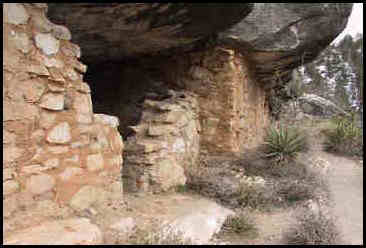Walk Through Time Indian Ruins Tours
This is your chance to get a glimpse of prehistoric life as you visit three National Monuments and the Elden Pueblo trenches of a working archaeological site, all in the Flagstaff Arizona area. Included on this tour are visits to Walnut Canyon National Monument, Wupatki National Monument, Sunset Crater National Monument and the Elden Pueblo ruins.
 |
||
|
Walnut Canyon National Monument
Hike down into Walnut Canyon and walk in the footsteps of the people that lived here over 900 years ago. Under limestone overhangs, the Sinagua built their homes. These single story structures, cliff dwellings, were occupied from about 1100 to 1250. Look down into the canyon and imagine the creek running through. Visualize a woman hiking up from the bottom with a pot of water on her back. Imagine the men on the rim farming corn or hunting deer. Think of a cold winter night with your family huddled around the fire. As you stand in rooms formed by walling up the opening under a rock overhang, you look down into Walnut Canyon's floor and wonder at the tenacity of the families who managed to hunt and farm and keep ward in such a place. The people that lived here moved on to become the modern pueblo people of today. Walnut Canyon is one of their ancestral homes.
You can see history unraveled in the geology of the rocks, listen to the canyon wren, and enjoy turkey vultures soaring above. If you look closely, you may even see an elk, deer or javelin. Different life zones overlap here, mixing species that usually live far apart. In this canyon, desert cacti grow alongside mountain firs. This is a truly beautiful place to see!
Click Here to See More Photos of Indian Ruins
Wupatki National Monument
At Wupatki you may try to imagine the ball-court filled with screaming fans and the intense competition in a game whose rules we can only guess at. What was their opinion of the blow hole nearby?
For its time and place, there was no other pueblo like Wupatki. Less than 800 years ago, it was the tallest, largest, and perhaps the richest and most influential pueblo around. It was home to 85-100 people, and several thousand more lived within a day’s walk. It was built in one of the lowest, warmest, and driest places on the Colorado Plateau. What compelled people to build here? Human history here spans at least 10,000 years. But only for a time, in the 1100s, was the landscape this densely populated. The eruption of nearby Sunset Crater Volcano a century earlier probably played a part. Families that lost their homes to ash and lava had to move. They discovered that the cinders blanketing lands to the north could hold moisture needed for crops.
As the new agricultural community spread, small scattered homes were replaced by a few large pueblos, each surrounded by many smaller pueblos and pit houses. Wupatki, Wukoki, Lomaki, and other masonry pueblos emerged from bedrock. Trade networks expanded, bringing exotic items like turquoise, shell jewelry, copper bells, and parrots. Wupatki flourished as a meeting place of different cultures. Then, by about 1250, the people moved on.
The people of Wupatki came here from another place. From Wupatki, they sought out another home. Though no longer occupied, Wupatki is remembered and cared for, not abandoned.
Sunset Crater National Monument
The Bonito Lava Flow in the Sunset Crater National Monument still seems to move among the red and black cinder cones, caves and craters. All around are indications of the power and destructive force of a volcanic eruption that occurred some 800 years ago. Was it the reason for the sudden displacement of the residents of Walnut Canyon, Wupatki and other Sinagua pueblos in the area?
People must have been warned by tremors and earthquakes before red-hot rocks exploded from the ground and rained down on their pit houses and farmland. Perhaps some stayed to watch as their homes and farmland were buried under slow-moving lava flows. Most fled, taking their possessions with them. Billowing ash, falling cinders, and forest fires blackened the land and the daytime sky. At night, the horizon glowed fiery red. A large fire fountain, accompanied by lightning and a tremendous roar, could be seen and heard for hundreds of miles. It must have been the loudest noise these people had ever experienced.
When their world again grew quiet, people faced a dramatically altered land. New mountains, including the 1,000-foot-high cinder cone now known as Sunset Crater, stood where open meadows and forests had been. Black cinders blanketed the region.
Life in the shadow of the volcano was changed profoundly and forever. Some people relocated nearby at Walnut Canyon or Wupatki.
900 years later, Sunset Crater is still the youngest volcano on the Colorado Plateau. The volcano's red rim and the dark lava flows seem to have cooled and hardened to a jagged surface only yesterday. As plants return, so do the animals that use them for food and shelter. And so do human visitors, intrigued by this opportunity to see nature’s response to a volcanic eruption.
Elden Pueblo Ruins
At Elden Pueblo Ruin, you will not only see a prehistoric pueblo dated at about 1200 AD, but also view the grids and trenches of a working archaeological site. The site is unique for a number of reasons. Most important perhaps, it has played a groundbreaking role in making archaeology and the history of Arizona's earliest residents more accessible to the public. This ancient structure, much of which is still unexcavated, serves as a site for a hands-on archaeological summer camp for fourth to ninth grade public school students. The camp is hosted by the Coconino National Forest, and the Museum of Northern Arizona. At the camp students excavate right alongside professional archaeologists.